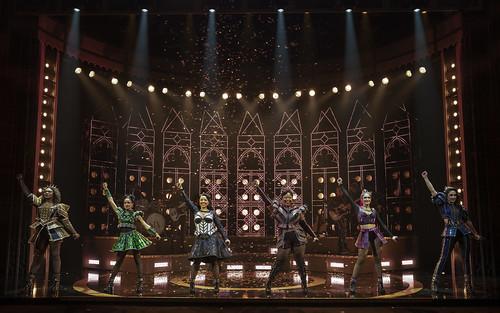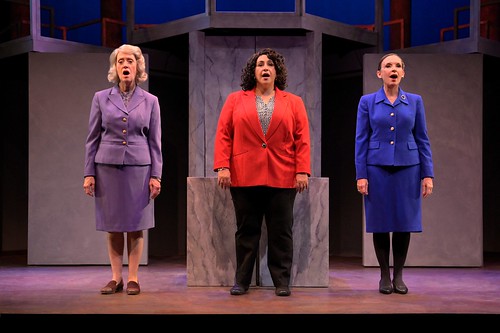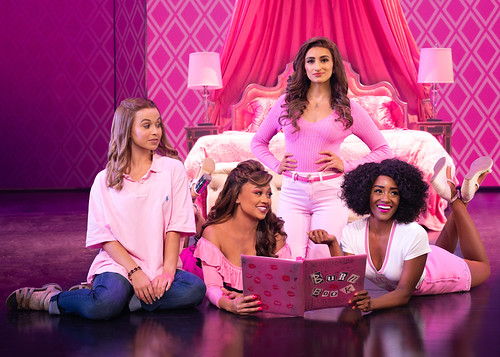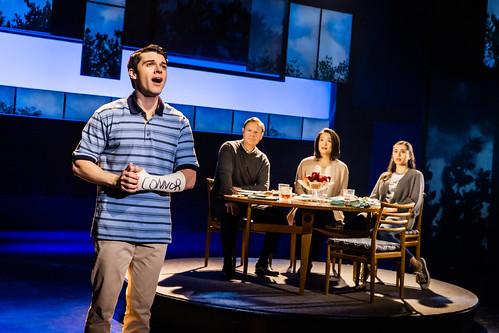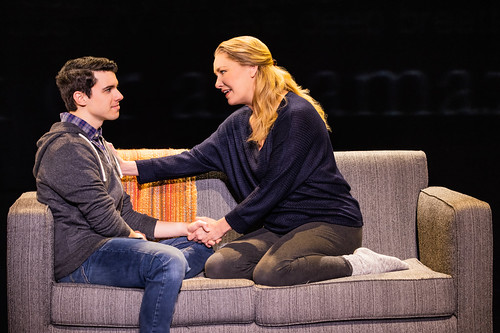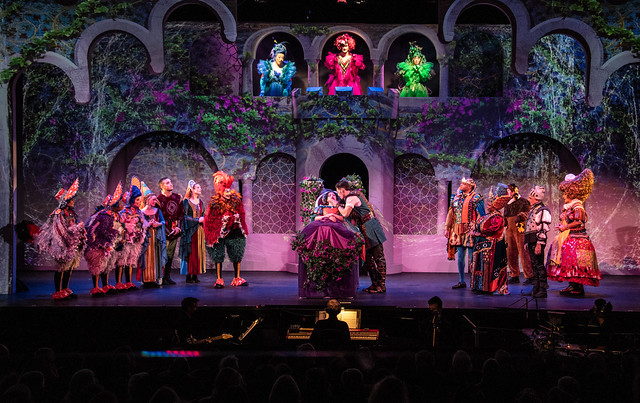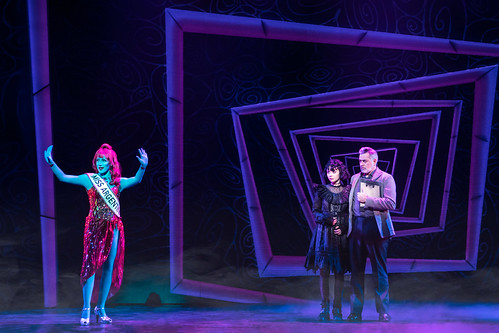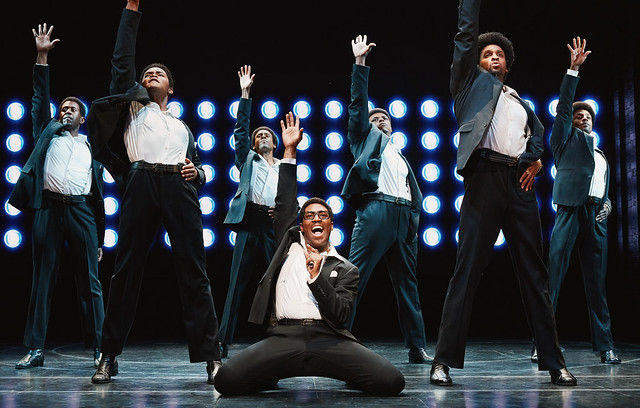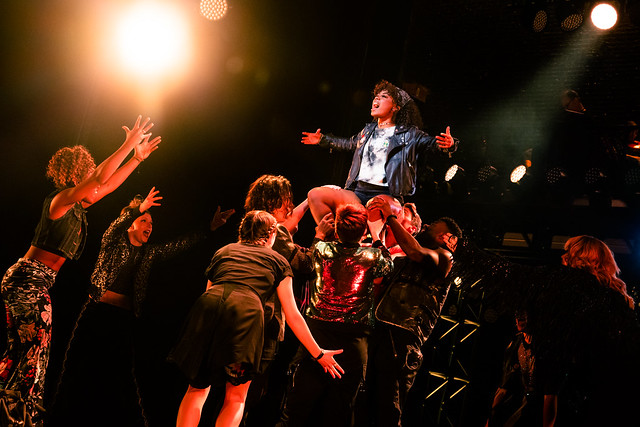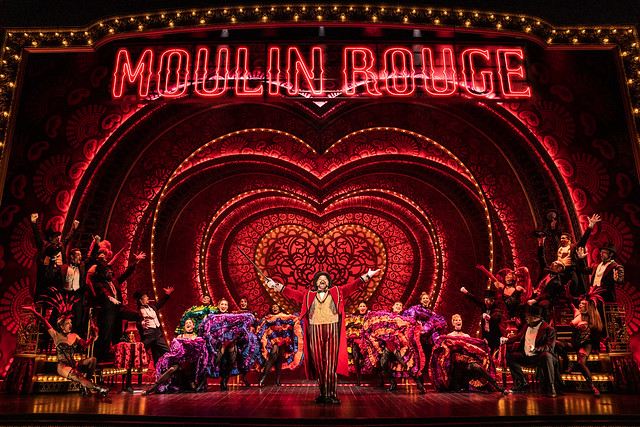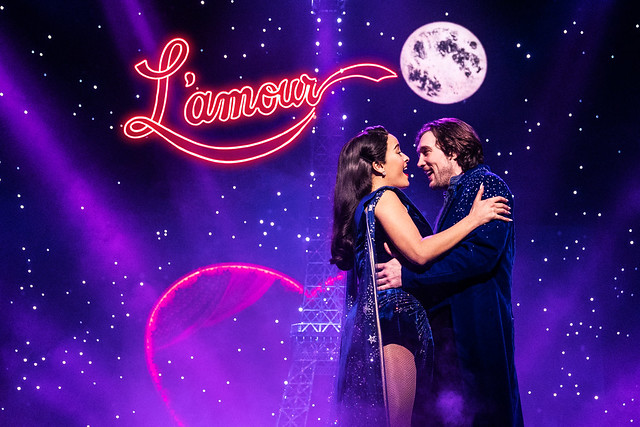
ABOVE: Olivia Donalson (center) as Anna of Cleves in the North American tour of SIX, part of the BroadwaySF season at the Orpheum Theatre. BELOW: The cast revives the six wives of King Henry VIII. Photos by Joan Marcus
If SIX, the peppy, poppy musical that attempts to “girl power” the six wives of King Henry VIII back into the spotlight, feels like an imaginative school project that has gotten way out of hand, well that’s pretty much what it is. Creators Toby Marlow and Lucy Moss began working on the show while they were still in college. The show, which brings back the wives as mock-Tudor versions of ’90s pop royalty such as Beyonce, Britney Spears, Ariana Grande and the like, made its debut at the Edinburgh Fringe Festival in 2017 and has taken its crusade to London’s West End and to Broadway, where the queens are still going strong.
There’s a lot of earnest good cheer and posturing in SIX, whose national tour has decamped to the Orpheum Theatre as part of the BroadwaySF season. The women are all glammed up in sparkly outfits (by Gabriella Slade that are part disco armor, part regal finery. They strut and fret for about 85 rambunctious minutes on an illuminated set (by Emma Bailey with exceedingly busy lighting design by Tim Deiling) that feels very much like the Las Vegas version of Hampton Court Palace.
This college project that has turned into an international mega-hit is primarily a concert, complete with the all-women band on stage, that has the wives competing with each other to see who had the most miserable time being married to old Hank Eight. That’s an awfully thin thread on which to hang a show, but there it is – another singing contest full of vocal one-upsmanship in which you expect Simon Cowell to show up and scowl.
Since SIX opened on Broadway (right before the lockdown but resumed in the fall of 2021), I’ve encountered friends who absolutely loved the show and its fierce embrace of campy/poppy sensibility to reframe historical figures. Others absolutely loathed it and feel its shallow history lesson does nothing but offer empty feminism in an aggressively sparkly package.
I fall somewhere in between. I enjoyed the show and really enjoyed the audience enjoying the show. With co-creator Moss co-directing alongside Jamie Armitage and Carrie-Anne Ingrouille choreographing, all the dazzle goes down pretty easily. The Orpheum swallows too many of the lyrics to fully appreciate their sass or their cleverness, but we get the gist.
My favorite song comes from Anne Boleyn played by the perfectly named Storm Lever. The sorry-not sorry chorus of “Don’t Lose Ur Head” is a particularly insistent ear worm (though Anne’s beheading jokes grow tiresome). But my favorite queen is Anna of Cleaves as played by the fabulous Olivia Donalson. Her solo is preceded by a fun house music homage called “Haus of Holbein” that blends portrait painting by Hans Holbein the Younger with Tinder. But then Anna, who apparently wasn’t as pretty as her portrait suggested, disappointed Henry. He had the marriage annulled and set her up in her own palace with her own accounts. According to “Get Down,” Anna loved living the life of an independent former queen and makes zero apologies for her lack of misery.
By the end, when the women realize their silly contest continues to define them as Henry’s wives and not as distinct individuals, their epiphany doesn’t really get the song full of rebellion and verve it deserves. Rather, they get that tried-and-true finale cliché of a mega-mix (or mega-six, as the case may be), trotting out songs we’ve heard but in shorter versions.
SIX wants to entertain and it does (especially those with a fondness for ’90s pop). But it also wants to be taken a little bit seriously as an example (hello, Hamilton) of re-writing women and people of color back into the historical narrative. That is certainly admirable, but SIX mostly sashays around that throne rather than fully claiming it.
FOR MORE INFORMATION
SIX continues through March 19 at the Orpheum Theatre, 1192 Market St., San Francisco, as part of the BroadwaySF season. Running time is 85 minutes (no intermission). Tickets are $66.50-$263.50 (subject to change). Call or visit broadwaysf.com. For every performance of SIX, a minimum of 20 tickets will be sold at $30 ($36, including fees) through Lucky Seat.

